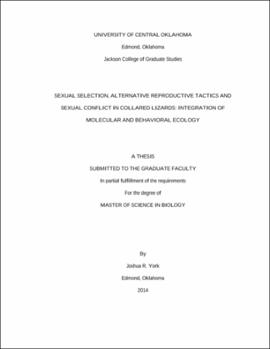| dc.contributor.advisor | Baird, Troy A. | |
| dc.contributor.author | York, Joshua R. | |
| dc.date.accessioned | 2020-07-10T20:07:55Z | |
| dc.date.available | 2020-07-10T20:07:55Z | |
| dc.date.issued | 2014 | |
| dc.identifier.other | (AlmaMMSId)9980690785202196 | |
| dc.identifier.uri | https://hdl.handle.net/11244/325173 | |
| dc.description.abstract | Sexual selection theory often predicts that socially dominant males should sire more offspring than males adopting subordinate social tactics. However, it is often difficult to determine the extent to which this expected distribution of male reproductive success is influenced by intra- and intersexual selection. Using a combination of field behavioral studies and molecular genetic techniques, I first tested the extent to which observations of social and spatial behavior predicted the distribution of reproductive success among female collared lizards and males displaying alternative social tactics (territorial and non-territorial) during a single reproductive season. I also examined the strength of sexual selection acting on male morphological and behavioral traits. Contrary to expectations, male social status did not accurately predict patterns of reproductive success: non-territorial males obtained reproductive success equal to that of territorial males and females were highly promiscuous, mating with a similar number of territorial and non-territorial males, both within and among successive clutches. None of the traits that I examined were significant targets of sexual selection among non-territorial males. However, male snout-vent-length was under positive directional selection among territorial males. To test the generality of my earlier findings, I expanded my analyses to encompass three seasons to examine how the number of female mates and offspring sired among males varied with marked natural variation in the intensity of intra- and intersexual selection within and among seasons, and the influence of behavioral traits on male fitness. I also examined how the degree of female promiscuity varied with changes in the intensity of sexual selection and the influence of female promiscuity on offspring survivorship. Unexpectedly, results from all seasons confirmed that non-territorial males consistently mated with similar numbers of females and sired similar numbers of offspring as territorial males. Moreover, females were promiscuous in all three seasons with similar numbers of territorial and non-territorial males. However, promiscuity decreased offspring survivorship. Together, my results suggest that mating relationships among collared lizards contrast sharply with predictions from classical mating system theory and likely represent the outcome of sexual conflict. Both sexual conflict and the high reproductive success of non-territorial males appear to be promoted by the homogeneous and continuous topography of the semi-natural habitat at my study site, which differs markedly from the natural habitat of collared lizards. | |
| dc.rights | All rights reserved by the author, who has granted UCO Chambers Library the non-exclusive right to share this material in its online repositories. Contact UCO Chambers Library's Digital Initiatives Working Group at diwg@uco.edu for the permission policy on the use, reproduction or distribution of this material. | |
| dc.subject.lcsh | Collared lizards | |
| dc.subject.lcsh | Crotaphytus collaris | |
| dc.subject.lcsh | Lizards | |
| dc.subject.lcsh | Reproduction | |
| dc.subject.lcsh | Reptiles | |
| dc.subject.lcsh | Sexual selection in animals | |
| dc.title | Sexual selection, alternative reproductive tactics and sexual conflict in collared lizards : integration of molecular and behavioral ecology. | |
| dc.type | Academic theses | |
| dc.contributor.committeeMember | Haynie, Michelle L., 1975- | |
| dc.contributor.committeeMember | Hellack, Jenna | |
| dc.thesis.degree | M.S., Biology | |
| dc.identifier.oclc | (OCoLC)ocn884966282 | |
| uco.group | UCO - Graduate Works and Theses::UCO - Theses | |
| thesis.degree.grantor | Jackson College of Graduate Studies | |
